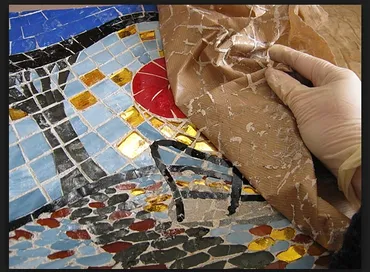
Mosaic Techniques: Direct, Indirect, Opus Styles & Modern Innovations
Introduction
Mosaics are more than materials—they are about method. The way tesserae are cut, arranged, and fixed determines the look, flow, and strength of the finished work. From Roman artisans meticulously laying marble cubes to modern mosaicists experimenting with mesh and recycled glass, technique is where mosaic craft meets mosaic art.
This post explores both ancient and modern methods: the opus styles of antiquity, the direct and indirect approaches of today, and the artistic principles—like andamento—that make mosaics come alive.
---
1. Understanding Andamento — The Flow of a Mosaic
Before diving into methods, one crucial concept: andamento.
Definition: The directional flow of tesserae in a mosaic.
It guides the eye, creates rhythm, and gives mosaics their characteristic “movement.”
Examples: wavy lines suggesting water, concentric circles framing a portrait, or radiating arcs highlighting a focal point.
Without andamento, a mosaic looks flat. With it, the design feels alive.
---
2. The Direct Method
The most common technique, especially for beginners and contemporary artists.
How it works: Tesserae are placed directly onto the final substrate (wood, cement, wall, etc.) with adhesive.
Advantages:
Immediate visual feedback.
Great for small projects, murals, and artworks.
Flexible—you can work in sections.
Limitations:
Harder to achieve perfectly flat surfaces.
Large-scale works require scaffolding or awkward working positions.
Modern uses: Kitchen splashbacks, mosaic portraits, decorative panels.
---
3. The Indirect Method
A technique invented to make installation easier for large or precise works.
How it works: Tesserae are glued face-down onto a temporary surface (paper, mesh, or film). Once the design is complete, the whole section is flipped and set into adhesive on the final surface.
Advantages:
Produces flat, even surfaces (great for floors).
Allows working in a studio, then transporting the mosaic.
Ideal for large projects and professional commissions.
Limitations:
You don’t see the final effect until it’s set.
Requires careful planning and flipping.
Modern uses: Public murals, swimming pools, floors, large walls.
---
4. The Double Indirect Method
A hybrid method used when mosaics need to be transported multiple times or repositioned.
Tesserae are first mounted face-up on mesh, then flipped face-down for indirect installation.
Useful for restoring ancient mosaics or creating portable artworks.
---
5. Mosaic on Mesh
A modern solution bridging direct and indirect techniques.
Tesserae are mounted directly onto fiberglass mesh in manageable sections.
Sections can then be installed like tiles, making large mosaics easier to assemble.
Common for architectural mosaics and commercial art projects.
---
6. Ancient Roman Opus Styles
Romans developed several distinctive opus (Latin for “work”) styles that still influence mosaics today:
Opus Tessellatum:
Standard method using medium-sized square tesserae.
Good for large, bold patterns and floors.
Opus Vermiculatum:
Extremely fine tesserae (as small as 1 mm).
Used for shading, detail, and illusion of depth.
Often placed inside larger opus tessellatum borders.
Opus Sectile:
Large, shaped pieces fitted together (like a jigsaw).
More about geometry than tiny detail.
Opus Palladianum (or Opus Incertum):
Irregular stone fragments, often leftovers.
Common in rustic pavements, today echoed in crazy paving.
Opus Musivum:
Decorative wall and vault mosaics, often with gold smalti.
---
7. Byzantine Innovations
Byzantine artists perfected glass mosaics for walls and domes.
Used smalti, cut unevenly to catch light.
Often set tesserae at slight angles to sparkle under candlelight.
Favored for religious iconography and symbolism.
---
8. Islamic Mosaic Techniques
Islamic artisans focused on geometry and pattern rather than figurative imagery.
Zellige (Morocco): Tiny hand-cut ceramic tiles assembled into intricate star patterns.
Mosaic Faience (Persia): Glazed tiles cut and reassembled into elaborate calligraphy and ornament.
---
9. Modern Innovations in Technique
Today’s mosaicists experiment beyond tradition:
Trencadís: Broken pottery/tiles arranged into irregular surfaces (Gaudí’s signature).
Digital Mosaic: Photographic images translated into tesserae arrangements.
3D Mosaic: Sculptural surfaces, not just flat planes.
Mixed Media: Incorporating beads, shells, metal, and found objects.
---
10. Cutting & Setting Tesserae
Technique isn’t just about layout—it’s about handling materials.
Hammer & Hardie (traditional tool): For splitting stone/smalti.
Nippers & Cutters: For ceramic and glass.
Precision Matters: Clean cuts ensure better andamento.
Angles: Slight tilts can change how light reflects.
---
11. Grouting & Finishing
The last stage of technique is often overlooked.
Grout Color: Can unify, contrast, or completely change the mood.
Sealing: Important for outdoor mosaics.
Texture: Smooth vs. textured finishes create different effects.
---
12. Choosing a Technique
When deciding which technique to use, ask:
Scale: Small art piece → direct. Large mural → indirect or mesh.
Location: Outdoor → indirect with durable adhesives. Indoor → direct works fine.
Style: Figurative with shading → opus vermiculatum or direct. Geometric → opus sectile, zellige.
Budget/Time: Indirect is more efficient for mass production, direct is slower but flexible.
---
Conclusion
Mosaic techniques are as varied as the materials they employ. From Roman opus tessellatum to Gaudí’s trencadís, each method reflects a marriage of practicality and artistry. Understanding these approaches gives us not only technical insight but also a window into the cultural values of their times.
Whether you’re laying glass smalti piece by piece in a direct method or cutting ceramic tiles for a Moroccan-inspired zellige, the choice of technique shapes the soul of the mosaic.